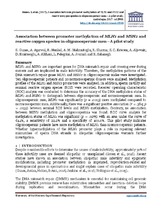Association between promoter methylation of MLH1 and MSH2 and reactive oxygen species in oligozoospermic men—A pilot study
Date
2017Author
Gunes, S.
Agarwal, A.
Henkel, Ralf
Sharma, Rajan
Esteves, S.C.
Aljowair, A.
Emirzeoglu, D.
Alkhani, A.
Pelegrini, L.
Joumah, A.
Sabanegh, E.
Mahmutoglu, A.M.
Metadata
Show full item recordAbstract
MLH1 and MSH2 are important genes for DNA mismatch repair and crossing over during
meiosis and are implicated in male infertility. Therefore, the methylation patterns
of the DNA mismatch repair genes MLH1 and MSH2 in oligozoospermic males were
investigated. Ten oligozoospermic patients and 29 normozoospermic donors were
analysed. Methylation profiles of the MLH1 and MSH2 promotors were analysed. In
addition, sperm motility and seminal reactive oxygen species (ROS) were recorded.
Receiver operating characteristic (ROC) analysis was conducted to determine the accuracy
of the DNA methylation status of MLH1 and MSH2 to distinguish between oligozoospermic
and normozoospermic men. In oligozoospermic men, MLH1 was
significantly (p = .0013) more methylated compared to normozoospermic men.
Additionally, there was a significant positive association (r = .384; p = .0159) between
seminal ROS levels and MLH1 methylation. Contrary, no association between MSH2
methylation and oligozoospermia was found. ROC curve analysis for methylation status
of MLH1 was significant (p = .0275) with an area under the curve of 61.1%, a sensitivity
of 22.2% and a specificity of 100.0%. This pilot study indicates oligozoospermic
patients have more methylation of MLH1 than normozoospermic patients. Whether
hypermethylation of the MLH1 promoter plays a role in repairing relevant mismatches
of sperm DNA strands in idiopathic oligozoospermia warrants further investigation.

